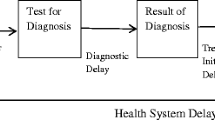Abstract
Effective treatment for tuberculosis (TB) patients on first-line treatment involves triaging those with drug-resistant (DR) TB to appropriate treatment alternatives. Patients likely to have DR TB are identified using results from repeated inexpensive sputum-smear (SS) tests and expensive but definitive drug sensitivity tests (DST). Early DST may lead to high costs and unnecessary testing; late DST may lead to poor health outcomes and disease transmission. We use a partially observable Markov decision process (POMDP) framework to determine optimal DST timing. We develop policy-relevant structural properties of the POMDP model. We apply our model to TB in India to identify the patterns of SS test results that should prompt DST if transmission costs remain at status-quo levels. Unlike previous analyses of personalized treatment policies, we take a societal perspective and consider the effects of disease transmission. The inclusion of such effects can significantly alter the optimal policy. We find that an optimal DST policy could save India approximately $1.9 billion annually.



Similar content being viewed by others
References
World Health Organization (2014) Global tuberculosis report 2014. http://apps.who.int/iris/bitstream/10665/137094/1/9789241564809_eng.pdf
India Ministry of Health and Family Welfare (2010) Revised National Tuberculosis Control Programme (RNTCP) training module for medical practitioners. http://tbcindia.nic.in/pdfs/Training%20Module%20for%20Medical%20Practitioners.pdf
India Ministry of Health and Family Welfare (2010) RNTCP performance report, India: third quarter, 2010. http://www.tbcindia.nic.in/WriteReadData/l892s/1778097518Perf%203Q%202010.pdf
World Health Organization (2015) Country profile: http://www.who.int/countries/ind/en/
India Ministry of Health and Family Welfare (2017) Revised National Tuberculosis Control Programme national strategic plan for tuberculosis elimination 2017–2025. http://tbcindia.gov.in/WriteReadData/NSP%20Draft%2020.02.2017%201.pdf
Menzies NA, Cohen T, Lin H-H, Murray M, Salomon JA (2012) Population health impact and cost-effectiveness of tuberculosis diagnosis with Xpert MTB/RIF: a dynamic simulation and economic evaluation. PLoS Med 9(11):e1001347
Vassall A, van Kampen S, Sohn H, Michael JS, John KR, den Boon S, Davis JL, Whitelaw A, Nicol MP, Gler MT, Khaliqov A, Zamudio C, Perkins MD, Boehme CC, Cobelens F (2011) Rapid diagnosis of tuberculosis with the Xpert MTB/RIF assay in high burden countries: a cost-effectiveness analysis. PLoS Med 8(11):e1001120
Choi HW, Miele K, Dowdy D, Shah M (2013) Cost-effectiveness of XpertMTB/RIF for diagnosing pulmonary tuberculosis in the United States. Int J Tuberc Lung Dis 17(10):1328–1335
You JH, Lui G, Kam KM, Lee NL (2015) Cost-effectiveness analysis of the Xpert MTB/RIF assay for rapid diagnosis of suspected tuberculosis in an intermediate burden area. J Infect 70(4):409–414
Castillo-Chavez C, Song B (2004) Dynamical models of tuberculosis and their applications. Math Bio Eng 1(2):361–404
Porco TC, Blower SM (1998) Quantifying the intrinsic transmission dynamics of tuberculosis. Theor Popul Biol 54(2):117–132
Liu L, Zhaob XQ, Zhou Y (2010) A tuberculosis model with seasonality. Bull Math Biol 72(4):931–952
Suen S, Bendavid E, Goldhaber-Fiebert JD (2014) Disease control implications of India’s changing multi-drug resistant tuberculosis epidemic. PLoS One 9(3):e89822
Suen SC, Bendavid E, Goldhaber-Fiebert JD (2015) Cost-effectiveness of improvements in diagnosis and treatment accessibility for tuberculosis control in India. Int J Tuberc Lung Dis 19(9):1115–1124
Keeling MJ, Rohani P (2008) Modeling infectious diseases in humans and animals. Princeton University Press, Princeton
Mossong J, Hens N, Jit M, Beutels P, Auranen K, Mikolajczyk R, Massari M, Salmaso S, Tomba GS, Wallinga J, Heijne J, Sadkowska-Todys M, Rosinska M, Edmunds WJ (2008) Social contacts and mixing patterns relevant to the spread of infectious diseases. PLoS Med 5(3):e74
Horby P, Pham QT, Hens N, Nguyen TT, Le QM, Dang DT, Nguyen ML, Nguyen TH, Alexander N, Edmunds WJ, Tran ND, Fox A, Nguyen TH (2011) Social contact patterns in Vietnam and implications for the control of infectious diseases. PLoS One 6(2):e16965
Ayer T, Alagoz O, Stout N (2012) A POMDP approach to personalize mammography screening decisions. Oper Res 60(5):1019–1034
Maillart LM, Ivy JS, Ransom S, Diehl K (2006) Assessing dyna- mic breast cancer screening policies. Oper Res 56(6):1411–427
Goulionis JE, Vozikis A (2009) Medical decision making for patients with Parkinson disease under Average Cost Criterion. Aust New Zealand Health Policy 6:15
Hoey J, Poupart P, Von Bertoldi A, Craig T, Boutilier C, Milhailidis A (2010) Automated handwashing assistance for persons with dementia using video and a partially observable Markov decision process. Comput Vis Image Und 114(5):503–519
Smallwood RD, Sondik EJ (1973) The optimal control of partially observable Markov processes over a finite horizon. Oper Res 21(5):1071–1088
World Health Organization (2014) Cost-effectiveness and strategic planning (WHO-CHOICE): cost-effectiveness http://www.who.int/choice/costs/CER-thresholds/en/
India Ministry of Health and Family Welfare (2015) 2015 Revised National TB Control Programme annual status report. http://www.tbcindia.nic.in/showfile.php?lid=3166
Cohesive India (2010) Collaborations for health system improvement and impact evaluation in India. http://www.cohesiveindia.org/research-projects.html#best
World Health Organization (2013) Automated real-time nucleic acid amplification technology for rapid and simultaneous detection of tuberculosis and rifampicin resistance: Xpert MTB/RIF assay for the diagnosis of pulmonary and extrapulmonary TB in adults and children. Policy update. http://apps.who.int/iris/bitstream/10665/112472/1/9789241506335_eng.pdf
World Health Organization (2015) Use of high burden country lists for TB by WHO in the post-2015 era. http://www.who.int/tb/publications/global_report/high_tb_burdencountrylists2016-2020.pdf
World Health Organization (2016) HIV drug resistance surveillance guidance: 2015 update. http://apps.who.int/iris/bitstream/10665/204471/1/9789241510097_eng.pdf?ua=1
Kapoor SK, Raman AV, Sachdeva KS, Satyanarayana S (2012) How did the TB patients reach DOTS services in Delhi? A study of patient treatment seeking behavior. PLoS One 7(8): e42458
Srikanth P, Kamesh S, Daley P (2009) Bleach optimization of sputum smear microscopy for pulmonary tuberculosis. Indian J Tuberc 56(4):174–184
Acknowledgments
Financial support for this study was provided in part by a National Science Foundation Graduate Research Fellowship under grant DGE-114747 (Sze-chuan Suen), the National Institute on Aging (K01 AG037593; PI: Goldhaber-Fiebert) and by Stanford’s Freeman Spogli Institute’s Underdevelopment Action Fund (PI: Goldhaber-Fiebert). Margaret Brandeau was supported by Grant Number 1-R01-DA15612 from the National Institute on Drug Abuse.
Author information
Authors and Affiliations
Corresponding author
Electronic supplementary material
Below is the link to the electronic supplementary material.
Rights and permissions
About this article
Cite this article
Suen, Sc., Brandeau, M.L. & Goldhaber-Fiebert, J.D. Optimal timing of drug sensitivity testing for patients on first-line tuberculosis treatment. Health Care Manag Sci 21, 632–646 (2018). https://doi.org/10.1007/s10729-017-9416-4
Received:
Accepted:
Published:
Issue Date:
DOI: https://doi.org/10.1007/s10729-017-9416-4




